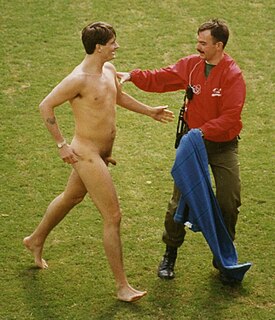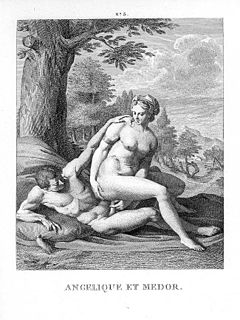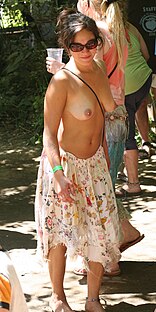 W
WNudity is the state of being in which a human is without clothing or specifically not covering the genitals. Partial nudity may be defined as not covering other parts of the body deemed sexual. Nudity is culturally complex due to meanings given various states of undress in differing social situations. In any particular society, these meanings are defined in relation to being properly dressed, not in relation to the specific body parts being exposed. Nakedness and clothing are connected to many cultural categories such as identity, privacy, social status and moral behavior. Although often used interchangeably, "naked" and "nude" are also used in English to distinguish between the various meanings of being unclothed.
 W
WAnasyrma composed of ἀνά ana "up, against, back", and σύρμα syrma "skirt"; plural: anasyrmata (ἀνασύρματα), also called anasyrmos (ἀνασυρμός), is the gesture of lifting the skirt or kilt. It is used in connection with certain religious rituals, eroticism, and lewd jokes. The term is used in describing corresponding works of art.
 W
WBathing is the washing of the body with a liquid, usually water or an aqueous solution, or the immersion of the body in water. It may be practiced for personal hygiene, religious ritual or therapeutic purposes. By analogy, especially as a recreational activity, the term is also applied to sun bathing and sea bathing.
 W
WA body cavity search, also known simply as a cavity search, is either a visual search or a manual internal inspection of body cavities for prohibited materials (contraband), such as illegal drugs, money, jewelry, or weapons. Body cavities frequently used for concealment include the mouth, vagina, and rectum. It is far more invasive than the standard strip search that is typically performed on individuals taken into custody, either upon police arrest or incarceration at a jail, prison, or psychiatric hospital. Often the procedure is repeated when the person leaves the institution.
 W
WThe social attitudes to and legal status of breastfeeding in public vary widely in cultures around the world. In many countries, both in the Global South and in a number of Western countries, breastfeeding babies in open view of the general public is common and generally not regarded as an issue. In many parts of the world including Australia, some parts of the United States and Europe, along with some countries in Asia, women have an explicit legal right to nurse in public and in the workplace.
 W
WCandaulism, or candaulesism, is a paraphilic sexual practice or fantasy in which one person exposes their partner, or images of their partner, to other people for their voyeuristic pleasure. Candaulism is also associated with voyeurism and exhibitionism.
 W
WOlga Desmond was a German dancer, actress, art model and living statue.
 W
WExhibitionism is the act of exposing in a public or semi-public context one's intimate parts – for example, the breasts, genitals or buttocks. The practice may arise from a desire or compulsion to expose themselves in such a manner to groups of friends or acquaintances, or to strangers for their amusement or sexual satisfaction, or to shock the bystander. Exposing oneself only to an intimate partner is normally not regarded as exhibitionism. In law, the act of exhibitionism may be called indecent exposure, "exposing one's person", or other expressions.
 W
WFriday is one of the main characters of Daniel Defoe's 1719 novel Robinson Crusoe. Robinson Crusoe names the man Friday, with whom he cannot at first communicate, because they first meet on that day. The character is the source of the expression "Man Friday", used to describe a male personal assistant or servant, especially one who is particularly competent or loyal. Current usage also includes "Girl Friday".
 W
WThe Gymnopaedia was an annual festival celebrated exclusively in ancient Sparta, helped to define Spartan identity. It featured generations of naked Spartan men participating in war dancing and choral singing, with a large emphasis placed on age and generational groups. It is believed that celebration of this festival began in 668 BCE to honour a Spartan victory in Thyrea. The festival likely evolved over time to celebrate other Spartan victories such as that over the Argives in the Battle of the Champions. The Gymnopaedia was primarily in honour of Apollo, but also celebrated Artemis and Leto, who served as representations of the childhood which would soon be left behind by the young participants. Though the festival was ritualistic, it should not necessarily be interpreted as religious. Pausanias describes the Gymnopaedia as "a festival which the Lacedaemonians take more seriously than any other".
 W
WHeroic nudity or ideal nudity is a concept in classical scholarship to describe the un-realist use of nudity in classical sculpture to show figures who may be heroes, deities, or semi-divine beings. This convention began in Archaic and Classical Greece and continued in Hellenistic and Roman sculpture. The existence or place of the convention is the subject of scholarly argument.
 W
WThe history of nudity involves social attitudes to nakedness of the human body in different cultures in history. The use of clothing to cover the body is one of the changes that mark the end of the Neolithic, and the beginning of civilizations. Nudity has traditionally been the social norm for both men and women in some hunter-gatherer cultures in warm climates and it is still common among many indigenous peoples. The need to cover the body is associated with human migration out of the tropics into climates where clothes were needed as protection from sun, heat, and dust in the Middle East; or from cold and rain in Europe and Asia. The first use of animal skins and cloth may have been as adornment, along with body modification, body painting, and jewelry, invented first for other purposes, such as magic, decoration, cult, or prestige. The skills used in their making were later found to be practical as well.
 W
WIndecent exposure is an expression that describes the deliberate public exposure by a person of a portion of their body in a manner contrary to local standards of appropriate behavior. Laws and social attitudes regarding indecent exposure vary significantly in different countries. It ranges from outright prohibition to prohibition of exposure of certain body parts, such as the genital area, buttocks or breasts.
 W
WAn art model poses, often nude, for visual artists as part of the creative process, providing a reference for the human body in a work of art. As an occupation, modeling requires the often strenuous 'physical work' of holding poses for the required length of time, the 'aesthetic work' of performing a variety of interesting poses, and the 'emotional work' of maintaining a socially ambiguous role. While the role of nude models is well-established as a necessary part of artistic practice, public nudity remains transgressive, and models may be vulnerable to stigmatization or exploitation. Artists may also have family and friends pose for them, in particular for works with costumed figures.
 W
WMooning is the act of displaying one's bare buttocks by removing clothing, e.g., by lowering the backside of one's trousers and underpants, usually bending over, and also potentially exposing the genitals. Mooning is used in the English-speaking world to express protest, scorn, disrespect, or for provocation, but mooning can be done for shock value, for fun, as a joke or as a form of exhibitionism. The Māori have a form of mooning known as Whakapohane that is a form of insult.
 W
WThe Naked Maja is a philatelic name for three postage stamps of Spain of 1930 depicting the La maja desnuda painting (1800) by Francisco de Goya (1746–1828). They are part of a set marking the anniversary of the death of this Spanish artist, and are considered the world's first postage stamp with nudes.
 W
WNude weddings, also known as naked marriages, are weddings that may include the couple, bridal parties, and/or guests in the nude. Participants may be committed to the nudist lifestyle or want a different kind of wedding.
 W
WThe practice of entering combat without the use of clothing and armor has been documented on several occasions in history. The artistic convention of heroic nudity was established in the art of ancient Greece by the Archaic period.
 W
WNyotaimori , often referred to as "body sushi", is the Japanese practice of serving sashimi or sushi from the naked body of a woman. Nantaimori (男体盛り) is the male equivalent.
 W
WPublic sex is sexual activity that takes place in a public context. It refers to one or more persons performing a sex act in a public place, or in a private place that can be viewed from a public place.
 W
WRockbitch was a British, mostly female, lesbian and bisexual metal band, who performed nude and incorporated sexual acts and Pagan rituals into their performances.
 W
WA strip search is a practice of searching a person for weapons or other contraband suspected of being hidden on their body or inside their clothing, and not found by performing a frisk search, but by requiring the person to remove some or all clothing. The search may involve an official performing an intimate person search and inspecting their personal effects and body cavities. A strip search is more intrusive than a frisk and requires legal authority. Regulations covering strip searches vary considerably and may be mandatory in some situations or discretionary in others.
 W
WA stripper or exotic dancer is a person whose occupation involves performing striptease in a public adult entertainment venue such as a strip club. At times, a stripper may be hired to perform at a bachelor party or other private event.
 W
WTissiflashmob was a demonstration organised by Sandra Marins and Säde Vallarén, which was held for the first time in June 2019 at the Hietaniemi beach in Helsinki, Finland. The organisers held the demonstration in criticism for a previous event where a woman had been removed from a beach for sunbathing topless.
 W
WTopfreedom is a cultural and political movement seeking changes in laws to allow women to be topless in public places where men are permitted to be barechested, as a form of gender equality. Specifically, the movement seeks the repeal or overturning of laws which restrict a woman's right not to have her chest covered at all times in public.
 W
WToplessness refers to the state in which a woman's breasts, including her areolas and nipples, are exposed, especially in a public place or in a visual medium. The male equivalent is barechestedness, also commonly called shirtlessness.
 W
WUmhlanga [um̩ɬaːŋɡa], or Reed Dance ceremony, is an annual Swazi event. In Eswatini, tens of thousands of unmarried and childless Swazi girls and women travel from the various chiefdoms to the Ludzidzini Royal Village to participate in the eight-day event. The young, unmarried girls were placed in female age-regiments; girls who had fallen pregnant outside wedlock had their families fined a cow.
 W
WAn undress code is a dress code or social norm which sets an upper limit on the amount of clothing that can or should be worn.
 W
WA wet T-shirt contest is a competition involving exhibitionism, typically featuring young women contestants at a nightclub, bar, or resort. Wet T-shirt contestants generally wear white or light-colored T-shirts without bras, bikini tops, or other garments beneath. Water is then sprayed or poured onto the participants' chests, causing their T-shirts to turn translucent and cling to their breasts. The comparatively rarer male equivalent is the wet boxer contest, sometimes held at gay bars.